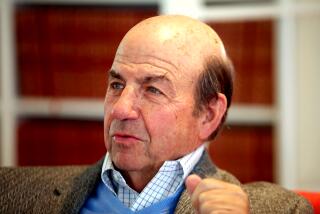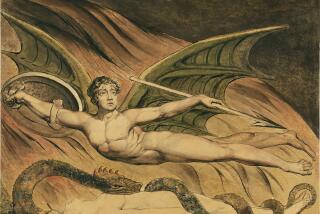Master of metaphors and metaphysics
The holy grail of the author’s own collector’s quest is the 1961 1s 3d Parliamentary Conference stamp, which he recalls as being “the most beautiful small object I had ever seen” as a boy. On this stamp, the head of the queen, which should by rights have occupied the top half of the stamp, was missing -- leaving an enchanting and suggestive blank space.
-- Katherine Sterling, review of Simon Garfield’s “Error World,” TLS, May 20, 3008
What are metaphors for? Before finding fame as the 20th century’s greatest compiler and theorist of weird news, not to mention one of its most audacious and influential autodidacts, Charles Fort (1849-1932) was a journalist and pulp-story writer who amassed inventive ways to describe one thing in terms of something else. Among the few to glimpse these scraps was no less a literary titan than Theodore Dreiser, who was Fort’s early magazine editor and steadfast champion. Bowled over, Dreiser offered to buy the odd collection from Fort. “They are better than any thesaurus,” he raved, “a new help to letters.”
According to Jim Steinmeyer’s perceptive and entertaining new biography, “Charles Fort: The Man Who Invented the Supernatural” (Tarcher/Penguin: 332 pp., $24.95), some of the 25,000 metaphors found their way into his tenement-based pulp fiction and “The Outcast Manufacturers” (1909), his only novel. A sailor’s forehead has “[e]xactly five wrinkles in it, as if it had been pressing upon banjo strings.” One woman possesses a “nose like a tiny model of a subway entrance; nostrils almost perpendicular and shaped like the soles of tiny feet.” Steinmeyer writes that Fort would often tinker with the metaphor as it was unfolding, as if “continually whispering into the reader’s ear”: “[S]he flushed a little -- flushes like goldfish in an aquarium, fluttering in her globe-like, colorless face -- goldfish in a globe of milk, perhaps -- or goldfish struggling in a globe of whitewash, have it.”
Of these metaphors, Dreiser wrote: “It was amazing, the force or beauty of these sentences.” But Fort would soon burn this priceless hoard, as he turned from fiction to a new sort of writing, requiring the assembly of a different kind of hoard.
Of course, the burning of metaphors is itself a metaphor: A desire to start from scratch, see clearly, overthrow. (As that sentence demonstrates, all language is metaphor.) What he was working toward was an unsettling of established wisdom, and his books can warp one’s worldview as much as a whole library full of science fiction. For starters, he might understand “science fiction” as an equivalence: Science is fiction.
Fort was born in 1874 into a prominent Albany, N.Y., family of Dutch descent. He was the oldest of three tightly knit brothers. Their mother died young; their father, a prosperous wholesale grocer, was abusive, administering beatings and occasionally keeping them in virtual solitary confinement, so that any who were not condemned would sneak food in to the prisoners. Steinmeyer devotes ample space to the fascinating family dynamics, suggesting that the father’s rigid ideas of right and wrong -- and the family’s social standing -- contributed to Fort’s drive to overturn received ideas.
Adding another level of fascination to this often brutal account are the excerpts from “Many Parts,” Fort’s unpublished, fragmentary autobiography. The prose is both awkward and intense, owing to the strange compositional decision to speak in the “we” voice. (Though “we” suggests the band of brothers, it in fact refers only to Fort; his siblings appear as the Other Kid and the Little Kid.) And necessarily, the opposition -- Fort’s father -- is They. Fort recalls the day his youngest brother was sent to reform school: “We had been crying all afternoon, and felt that if there were the slightest reference to the Little Kid we should break down.” The emotional charge of this section is almost overwhelming, and gets trumped later when Fort makes a clandestine visit to the school.
Fort was an obsessive collector and a fitful student; thanks to his late mother’s brother, he found work at an Albany newspaper while still a teenager, and then became a reporter in Brooklyn and Queens. Hungry for more experience, at the tender age of 19, he resolved to “wander with a definite purpose.” With money from his grandfather’s estate, he traveled the world on 83 cents a day, as if to put the greatest distance between himself and his well-to-do upbringing.
His fearless globe-trotting stands in sharp contrast to the sedentary, reclusive nature of the life he would lead in New York. (Though Dreiser was his close friend, the two rarely met.) How is it that the same person can contain such extremes? But in the Fortean worldview, set forth in his later writings, there are no categories. Dichotomies disappear; there is -- a radical thought -- nothing to be resolved. “The difference between sea and land is not positive,” he suggested, in one of innumerable salvos. “In all water there is some earth: in all earth there is some water.” Or as he wrote in his last book, “Why this everlasting attempt to solve something?”
When Fort burned his metaphors, he was casting off the social-realist trappings of his fiction for a sort of nonfiction surrealism. Anchoring himself at the New York Public Library and later the British Museum, he eyeballed miles of newsprint for accounts of odd phenomena: showers of shellfish and other inexplicably displaced objects, amnesiacs and sea creatures, statues exhibiting the stigmata and rooms dripping oil. He dubbed these occurrences “damned,” meaning that science, unable to fit them into its system, excluded them altogether.
His researches grew into two manuscripts, “X” and “Y,” which tantalized Dreiser, who had adapted to Fort’s change in genre and was pulling every string to get him published. Though “X” and “Y” eventually went the way of the metaphor collection, “Z” became the basis for “The Book of the Damned” (1919). Ben Hecht wrote (in the Chicago Daily News) that “For every five people who read Charles Fort, four will go insane,” and meant it as a compliment. Steinmeyer sees “The Book of the Damned” as the true Baedeker to the uncertain, demented 1920s.
Three other omnium-gatherums would follow -- “New Lands” (1923), “Lo!” (1931) and “Wild Talents” (1932). All have just been republished as the omnibus “The Book of the Damned: The Collected Works of Charles Fort” (Tarcher/Putnam: 1,136 pp., $18.95 paper). Even for stretches where he is simply setting forth one example after another -- “There will be data,” he warns at the start of “New Lands” -- he delights, or at least keeps readers on their toes, with irreverent asides and koan-perfect editing. From “Lo!”:
“In the Field, Nov. 9 1895, the story of the ‘wolf child’ of Oude is told by an Assistant Commissioner, who had seen it. It was a speechless, little animal, about four years old. Policemen said that, in a wolf’s den, they had found this child, almost devoid of human intelligence. The child grew up and became a policeman.”
Fort loves pinpointing circular logic and opening absurd lines of inquiry. Dilating on fugue states that culminate with the person appearing naked in public, he plays both critic and defender.
“Wasn’t he ashamed of himself?. . . .
Don’t cats and horses and dogs go around without clothes on?
But they are clothed with natural, furry protections.
Well, Mexican dogs, then.”
Fort could be considered an heir of Emily Dickinson, in that he is a master of the dash. Early in “The Book of the Damned,” we get this found poem of sorts:
As to the logic of our expressions to come -- That there is only quasi-logic in our mode of seeming:
That nothing ever has been proved --
Because there is nothing to prove.
His dashes reproduce sudden stabs of thought and also suggest the blank spaces that are integral to his. “I confess to childish liking for making little designs, or arrangements of data, myself,” he wrote. “And every formal design depends upon blanks, as much as upon occupied spaces.”
Fort was the poet of blank spaces and twilight zones, and it’s not hard to read loss in those blanks: mother taken away from him, father a fist, brother lost to reform school and then drink, manuscripts burned. A possible definition of a perfect life might be one in which everything is a metaphor for everything else.
Ed Park’s Astral Weeks column appears monthly at latimes.com/books. He is an editor of the Believer and the author of the novel “Personal Days,” from which he will read at Booksoup on June 20. He blogs at The Dizzies.
More to Read
Sign up for our L.A. Times Plants newsletter
At the start of each month, get a roundup of upcoming plant-related activities and events in Southern California, along with links to tips and articles you may have missed.
You may occasionally receive promotional content from the Los Angeles Times.






